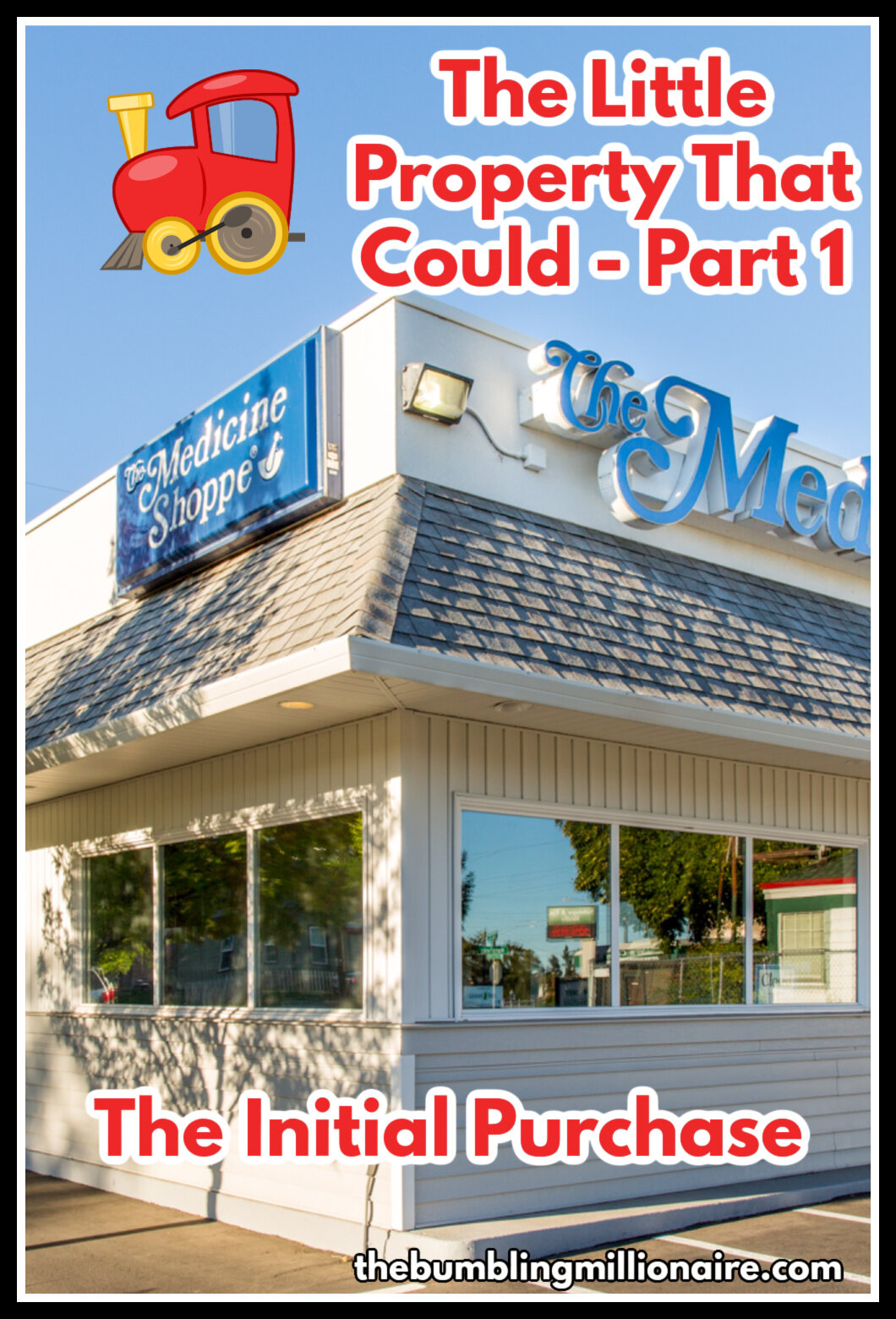The Little Property That Could – Part I - The Initial Purchase
/This is Part 1 of a 3 Part Series
Because this is an active deal, with both an existing tenant and partners, I can’t reveal certain deal terms. However, I will do my best to share what I learned.
This post may contain affiliate links. Learn more by reading my disclosure.
It was a small building with a single tenant, The Medicine Shoppe.
My investing partner, Kevin had cold-called the owner and asked if they wanted to sell.
It was 2010. The real estate market was still in turmoil and struggling to retain its value. The owners of the property were excited to hear from him and agreed to meet.
They toured the building and Kevin said he was interested in buying. Unfortunately, they couldn’t agree on price and Kevin didn’t want to let the deal slip away. He came up with an idea to get the deal across the goal line.
He suggested this, “To determine the sales price, what if we get an independent broker’s opinion of value? If you like the value and want to move forward with the sale, I’ll pay for the BOV. If you don’t agree with the value, we’ll split the cost of the BOV, 50/50, and go about our business. At worst, you’ll know the value of your building.”
The owners agreed to Kevin’s idea and the building was put under contract.
Broker's Opinion of Value
A Broker’s Opinion of Value (BOV) (or Broker’s Price Opinion (BPO)) is like an appraisal but with a few distinct differences.
First, brokers (or agents, depending on your state) are not trained appraisers. An appraiser has received very detailed training in the valuing of real estate. Brokers learn how to value real estate, too, but they also receive training in various other duties. Real estate brokers are often contacted by appraisers to get or verify information and vice versa.
Second, appraisals are more detailed than BOVs. However, a lot of this extra detail could be considered “fluff.” There is often general market background, including major employers, educators, etc. An appraisal can be a couple hundred pages or more depending on the type of property where a BOV can be done in as little as four pages. When trying to determine the value of an investment property, quickly and efficiently, a lot of investors don’t need the fluff, they just need the numbers.
The third major difference is cost. Appraisals cost significantly higher than a BOV, often starting at several thousand dollars, whereas a BOV could cost $1,000 or less depending on the time involved. Most lenders will use a BOV if the value of a property is less than $250,000. Appraisals are required for values above that.
This info is very different for residential real estate as I realize their BOVs and appraisals are dramatically less in costs.
Too Many Investors Want In
After Kevin had an agreement with the family, he called to tell me what he’d accomplished. I was impressed.
“Want to jump in to the deal?” he asked.
The Medicine Shoppe is a national franchise located in forty-one states. They are a neighborhood pharmacy. Think Walgreens or CVS, just smaller and more personable.
“Heck, yeah, I want in,” I said.
The seller and Kevin agreed on an outside broker to conduct the opinion of value. When the BOV came back, the property was valued at $200,000.
Kevin quickly built his proforma and the numbers looked solid.
The current owners were self-managing, a plan that we would continue with me handling the property management duties. The lease with The Medicine Shoppe was a modified net lease, with some leakage of expenses that would have to be managed. For example, it was the landlord’s responsibility to maintain and pay for landscaping. Not the best term in a lease, but not exactly one to cry about either.
Regardless, it seemed like a straight-forward exercise as a property manager and a role that I gladly accepted.
Kevin sent the initial packet to our lender to get them involved and sent the proforma to a few investors to gauge their interest.
This was our second deal together, but Kevin’s fifth. He was much more confident in the process, so I watched and I learned.
The initial deal we bought with 75% LTV (loan to value), meaning 75% was borrowed and we put 25% down.
We entered this deal thinking the same thing:
$200,000 purchase price x 25% = $50,000 down payment.
If I was going to be a 25% partner, I would need to come up with $12,500.
I had changed some of my spending habits at this point (looking back I was still a bit of a disaster), but I was squirrelling away money, especially my leasing commissions.
I didn’t know how I was going to come up with $12,500 but I wanted to buy another piece of real estate. Once you’re bitten by the real estate bug, you either get the fever or you’re inoculated and never go near it again. I was the former and couldn’t get enough.
Kevin came by a couple days later and said things were going great. The initial feedback was solid and we had a couple investors who wanted to jump in. We’d be able to take the building down without a problem.
I smiled. “That’s great,” I said, all the while thinking, “How the hell am I going to get to that $12,500?”
As the weeks passed and we worked on this deal, more commission checks arrived. Previously, I had spent these checks as part of my out-of-control habit, now I was putting them aside. My savings account balance was climbing and I believed I might just make that goal of $12,500.
Kevin came by my office one afternoon with a worried look on his face.
“What’s wrong, man?”
“Too many people want in the deal,” he said.
“What do you mean?”
“I have four people that want in with us. I told too many people about it.”
He looked sick and I really felt bad for my friend. “I’ll step out,” I said. “They’ll be other deals to get into.”
“No,” he said. “Don’t do that. If I can get them to do 20%, would you split the last 20% with me? That way we can all get in it.”
That seemed like an extremely small part of a deal, but less than a year prior I had no real estate and now I was talking about getting into my second commercial building.
I believed in Kevin and nodded. “You bet. I’ll do it.”
His face brightened immediately.
The Lender's Curve Ball
We had our partners lined up, the due diligence period had went smoothly and we removed the physical contingencies and were now only waiting on the lender’s approval (we still had a finance contingency in the contract).
That’s when the lender hit us with a curve ball. Instead of 25% down, they wanted 40%.
We couldn’t believe it.
The lender’s underwriter stated that Kevin, myself and a third partner were higher risks because we were partners in a deal that closed earlier that year. To secure that lending, we each had to personally guarantee the deal for $200,000.
The lender’s underwriter argued that the three of us each added an extra $200,000 of liability to our own balance sheets. We countered saying that they were basically penalizing the group $600,000 worth of liability for a $200,000 property. It shouldn’t have been counted three times.
Remember, it was 2010. The market was still struggling and banks were learning to deal with new lending requirements. It was a tough time to get deals done.
No manner of arguing was going to get the underwriter to change his mind.
Our down payment was now 40% or $80,000. ($200,000 x 40% = $80,000).
However, here’s where fate worked in my favor for me. I had saved just a bit over $8,000 which is what I needed for my 10%
There were no further hiccups and we closed on the deal. I was now a 10% partner in a small, single tenant building.
Was this the smartest use of my money?
Yes, for several reasons.
My previous spending habits were atrocious and I wasn’t saving anything. Starting to invest in real estate gave me my first real direction with personal finances. Even though it was only 10%, it was something and that’s more than most people. I’m proud of that small contribution because it was another step to building something.
About a year into ownership we did an owner’s disbursement so I recovered a small portion of my initial contribution. Had we continued do that it would have taken only a few years and my initial contribution would have been paid back in its entirety.
In the second article of this series, I’ll show how we bought out a partner for very little new cash.
In the third and final article, I’ll explain how we used this little property to buy another property without additional money, thereby giving me an ownership stake in two buildings.
Hang in there and you’ll see how that little 10% stake has grown considerably for me.
LESSONS LEARNED
Don’t Be Afraid to Call on an Unlisted Property
If a property isn’t listed for sale, it doesn’t mean an owner won’t sell. Successful real estate brokers spend a portion of their days contacting property owners to see if they will sell their unlisted property.
It’s amazing how many times someone sells a property because someone simply asked them. Landlords are like a lot of homeowners. The idea of selling may be in the back of their mind, but they get busy and it’s not a priority. They don’t really want to go through the hassle of getting the property ready for sale, interviewing brokers, etc. So, when someone shows up at the doorstep ready to make an offer, they are often willing to listen.
Often, these calls are a function of timing. The first broker calls and plants a seed by asking if the property owner would sell. When the property owner says “no,” they move about their days but they now have the thought “what if I had sold?” rolling around in the back of their mind. They may soon be thinking they could buy a new property or invest the money elsewhere. If something goes wrong on the property (i.e. a tenant vacates), the property owner may return to that question again. Not everyone will be affected by this, but some are. Then a second broker calls and asks the same question about selling. The property owner may be more receptive because they’ve sat with the question now for months or years.
I’ve heard this story many times from owners that I’ve called. “I wasn’t ready to sell the first time someone called, but I am now.”
Be Creative
Initially, Kevin and the sellers couldn’t agree on a price. That’s when he suggested an independent broker’s opinion of value. When the market is good, this technique is harder to make work. While real estate is hot, everyone thinks their property is worth a small gold-mine and there are enough buyers out there willing to over-pay.
However, when the market bottoms out, this technique worked great. It allowed the sellers to see what an independent individual thought their property was worth. That way they knew what they could sell it for if the deal possibly fell apart.
Don’t Oversell Your Deal
This was the first deal where we received too much desire to participate. What we learned from that is to include a caveat of first- come / first-served. Therefore, we can cut off the money and not get ourselves cut out of a deal.
However, we are often approached by investors who want to jump into deals before we’ve even put together the next one. It’s surprising how many folks out there want to get in.
It’s a learning process. When you first start, you think you need the money. However, once you’ve put a few deals together, you realize when you have an idea, they money will always find you.
Have you ever taken a small position
in an investment just to get in?
I'd love to hear you thoughts.
Or are you ready for More?
Here's the second part of the series
Part II - The Little Property That Could - A Partner Needs Out







